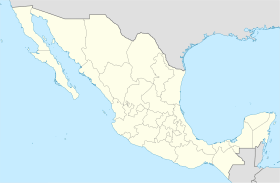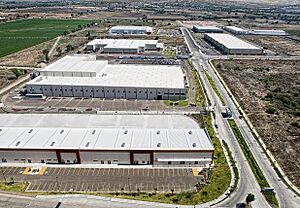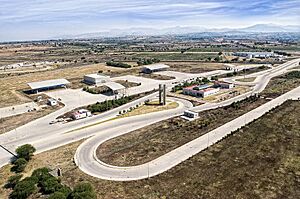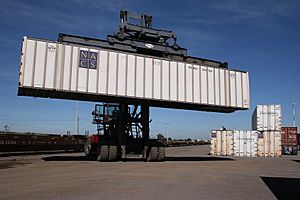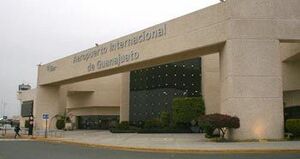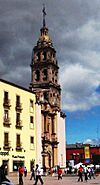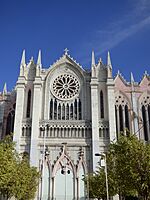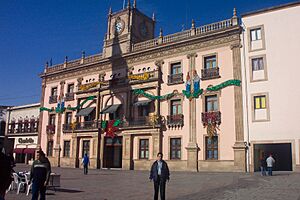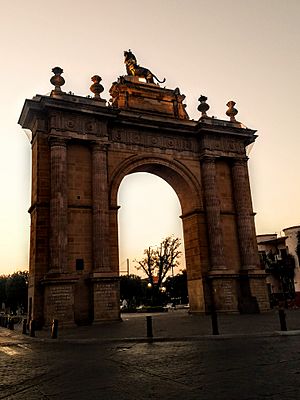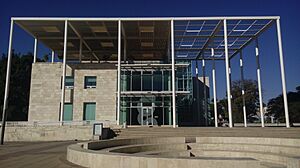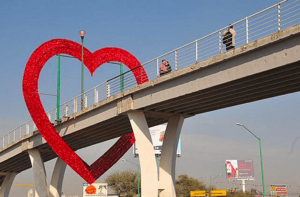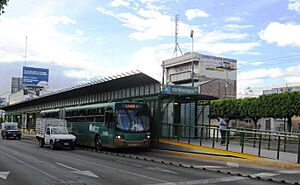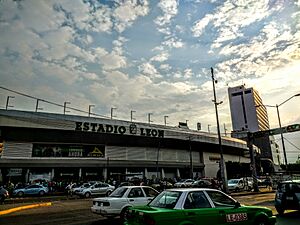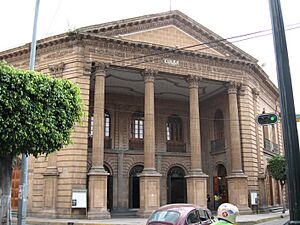León, Guanajuato facts for kids
Quick facts for kids
León
León de los Aldama
|
|||
|---|---|---|---|
|
City
|
|||

From top to bottom from left to right: Arco de la Calzada, Metropolitan Cathedral of León, Municipal House, Manuel Doblado Theater, Monument to Footwear, Expiatory Temple and View of wealthy neighborhoods of León
|
|||
|
|||
| Nicknames:
The Pearl of the Bajío, Emerald City, World Capital of Footwear
|
|||
| Motto(s): | |||
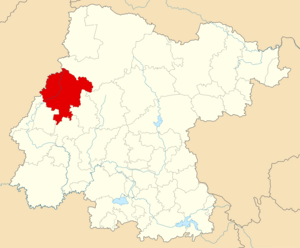 |
|||
| Country | |||
| State | |||
| Founded | January 20, 1576 | ||
| Founded as | Villa de León | ||
| Founded by | Martín Enríquez de Almanza | ||
| Area | |||
| • Land | 1,219.67 km2 (470.92 sq mi) | ||
| Elevation | 1,815 m (5,955 ft) | ||
| Population
(2020 Census)
|
|||
| • City | 1,721,199 | ||
| • Estimate
(2020)
|
1,721,199 | ||
| • Rank | 17th in North America 4th in Mexico |
||
| • Metro | 2,140,354 | ||
| • Demonym | Leonés(esa) | ||
| GDP (PPP, constant 2015 values) | |||
| • Year | 2023 | ||
| • Total (Metro) | $39.4 billion | ||
| • Per capita | $20,800 | ||
| Time zone | UTC−6 (CST) | ||
| • Summer (DST) | UTC−5 (CDT) | ||
| Area code(s) | +52 | ||
| Telephone exchange | 477 / 479 | ||
| Website | https://www.leon.gob.mx/ | ||
| Sources: National Institute of Statistics, Geography and Data Processing |
|||
León (pronounced lay-OWN), officially called León de Los Aldama, is a big city in the Mexican state of Guanajuato. It's the most populated city in the state. In 2020, over 1.7 million people lived in the city of León. If you count the surrounding areas, the population is over 2.1 million, making it one of the largest cities in Mexico. León is located in a region called Bajío in central Mexico.
León is famous for its large leather industry. They make many things like shoes, boots, belts, and jackets for people in Mexico and around the world. Because of this, workers in the leather industry were sometimes called "green belly" (panzaverde) from the green color that could get on their clothes and skin when treating leather. The city also offers great services and hotels, making it an important place for business and fun. You can find lots of entertainment, delicious food, and art here. León is also known as one of Mexico's most environmentally friendly cities. Many people ride bikes thanks to a network of bike lanes that are part of the city's public transport system. In 2012, León won an award for being a "City Water Champion" because of its efforts in cleaning water and reusing it.
Contents
Discovering León: A City's Journey
León's Ancient Past
Long ago, the area where León now stands was home to ancient cultures. Archeologists have found ten different sites from the Mesoamerican period. Many of these are linked to the Chupícuaro culture. Later, the powerful Teotihuacan and Toltec cultures also influenced the area. Around the 13th century, groups called Chichimecas moved into the region. They stayed there even after the Spanish arrived.
The Colonial Period: Founding a City
In 1530, a Spanish explorer named Nuño Beltrán de Guzmán came to the area. Spanish settlers started farming and raising cattle around 1546. However, the Chichimecas saw them as invaders and often caused trouble. The settlers asked for help from the leaders in Mexico City.
To help them, the viceroy, Martín Enríquez de Almanza, ordered a new city to be built. This city was named León in 1575. Juan Bautista de Orozco officially founded the village of León on January 20, 1576. It quickly grew and became an important center, governing many smaller towns and lands around it. For example, the towns of San Miguel and Coecillo were founded nearby. Spanish leaders settled Otomi people in San Miguel and Purépechas, Mexicas, and some Chichimecas in Coecillo. As more people moved to the area, some parts eventually became their own separate towns.
Important Changes and Challenges
In 1582, the first hospital was built in León. The Jesuits, a religious group, arrived in 1731 and started building churches. They began the Temple of the New Company, which later became the city's main cathedral. However, they couldn't finish it because they were asked to leave Mexico in 1767. In 1732, an important image of Our Most Holy Mother of Light arrived. She was later named the patron saint of the city in 1849.
The people of León faced many challenges over the years. They experienced sicknesses in 1643, long dry periods in 1630 and 1712–1714, and times of little food in 1714 and 1786. Floods also hit the city several times, including in 1637, 1749, 1762, and 1803.
León During Mexico's Wars
During Mexico's fight for independence, forces led by José Rafael de Iriarte came to León in 1810. But royalist forces, who supported the Spanish king, took the city back two months later. León remained under royalist control until the end of the Mexican War of Independence. The city finally celebrated its independence in 1825. In 1827, León became one of the main areas of the new state of Guanajuato, and in 1830, it officially became a city.
Later, during the La Reforma war (1858-1860), the city was taken by different groups, Liberals and Conservatives, many times. In 1862, León became the center of its own church region, called a bishopric. The first bishop, José María de Jesús Diez de Sollano y Dávalos, helped finish the towers and dome of the main church, which became the cathedral. He officially opened the cathedral in 1866.
From 1863 to 1866, French forces took over León during the French Intervention. Emperor Maximillian visited the city in 1864, and people celebrated his arrival with fireworks. After the French left, the Liberals took control. In 1867, a protest happened in the main plaza. This plaza is now called the "Plaza of the Martyrs" to remember the event.
León's Climate and Landscape
What's the Weather Like?
León generally has a warm climate with rain in the summer. The average temperature each year is about 19.9 degrees Celsius (67.8 degrees Fahrenheit). May is usually the warmest month, with temperatures reaching around 31.7 degrees Celsius (89.1 degrees Fahrenheit). January is the coolest month, with temperatures dropping to about 7.7 degrees Celsius (45.9 degrees Fahrenheit). In the mountains north of the city, the climate is a bit cooler.
León gets about 681 millimeters (26.8 inches) of rain each year. Most of this rain falls during the summer and early autumn, usually as thunderstorms in the evening. Snowfall is very rare in León. The last time snow was recorded was in 1997.
| Climate data for Downtown Leon | |||||||||||||
|---|---|---|---|---|---|---|---|---|---|---|---|---|---|
| Month | Jan | Feb | Mar | Apr | May | Jun | Jul | Aug | Sep | Oct | Nov | Dec | Year |
| Record high °C (°F) | 30.0 (86.0) |
33.0 (91.4) |
35.5 (95.9) |
42.2 (108.0) |
39.5 (103.1) |
38.0 (100.4) |
34.5 (94.1) |
36.0 (96.8) |
33.5 (92.3) |
37.0 (98.6) |
33.0 (91.4) |
36.5 (97.7) |
42.2 (108.0) |
| Mean daily maximum °C (°F) | 23.6 (74.5) |
25.7 (78.3) |
28.2 (82.8) |
30.5 (86.9) |
31.7 (89.1) |
29.9 (85.8) |
27.5 (81.5) |
27.6 (81.7) |
27.1 (80.8) |
26.9 (80.4) |
25.8 (78.4) |
24.0 (75.2) |
27.4 (81.3) |
| Daily mean °C (°F) | 15.7 (60.3) |
17.3 (63.1) |
19.5 (67.1) |
22.1 (71.8) |
23.7 (74.7) |
23.1 (73.6) |
21.3 (70.3) |
21.4 (70.5) |
21.0 (69.8) |
19.7 (67.5) |
17.9 (64.2) |
16.2 (61.2) |
19.9 (67.8) |
| Mean daily minimum °C (°F) | 7.7 (45.9) |
8.9 (48.0) |
10.9 (51.6) |
13.8 (56.8) |
15.7 (60.3) |
16.4 (61.5) |
15.2 (59.4) |
15.2 (59.4) |
14.8 (58.6) |
12.5 (54.5) |
10.0 (50.0) |
8.3 (46.9) |
12.5 (54.5) |
| Record low °C (°F) | 0.0 (32.0) |
−1.5 (29.3) |
0.0 (32.0) |
3.0 (37.4) |
8.5 (47.3) |
7.0 (44.6) |
7.0 (44.6) |
3.0 (37.4) |
5.0 (41.0) |
3.0 (37.4) |
1.0 (33.8) |
−2.5 (27.5) |
−2.5 (27.5) |
| Average rainfall mm (inches) | 15.1 (0.59) |
11.0 (0.43) |
5.7 (0.22) |
8.1 (0.32) |
24.6 (0.97) |
107.5 (4.23) |
182.6 (7.19) |
160.0 (6.30) |
111.5 (4.39) |
39.3 (1.55) |
9.4 (0.37) |
6.5 (0.26) |
681.3 (26.82) |
| Average rainy days (≥ 0.1 mm) | 2.7 | 1.6 | 1.3 | 2.0 | 4.9 | 11.6 | 16.2 | 13.3 | 10.3 | 5.0 | 1.3 | 1.4 | 71.6 |
| Source: SMN (normals 1981-2010, extremes 1947-2011) | |||||||||||||
City Views
León's Economy and Business
Industries and Jobs
León is a major hub for making shoes. About 70% of all shoes produced in Mexico come from León and its nearby areas. Besides Leather crafting, the city also has companies that make industrial chemicals, plastics, and parts for transportation. There's also a General Motors car plant in the nearby town of Silao. In the world of money, León is home to the main office of Banco del Bajío and regional offices for big banks like Banamex and HSBC.
Fast Customs and Shipping
There's a special facility at the Guanajuato Inland Port that helps businesses move their goods faster. Companies in this port can clear customs right there, instead of having to go to a border city or seaport. This makes shipping much easier.
There's also a rail yard that helps move goods by train. It offers services for shipping containers by rail and is run by Mexico's largest train company.
Trade Shows and Shopping
León hosts many trade fairs throughout the year at the Poliforum. The two biggest are Sapica, which is a shoe fair, and ANPIC, for suppliers to the shoe industry.
León also has several large shopping malls:
- Altacia: A big mall with stores like Liverpool, Cinépolis movie theaters, and the Sealand aquarium.
- City Center León: A new project that will have offices, hotels, shops, and apartments.
- Factory Shops León: A large outlet mall where you can find good deals.
- Plaza Galerías Las Torres: Another mall with stores like Walmart and Cinépolis.
- Plaza Mayor: This is the biggest mall in León. It has many stores, including Sears and Liverpool. A new, very fancy department store called Palacio de Hierro is also being built there.
Historic Sites: Exploring León's Past
The Grand Cathedral
León's main church is called the Cathedral Basilica of Our Lady of the Light. Building it started in 1746. It mixes two styles of architecture: Baroque and Neo Classic. Construction stopped when the Jesuits left Mexico, but the Obregon family continued the work. When León became an archdiocese in 1864, its first bishop helped finish the towers and dome. The cathedral was finally completed and opened on March 16, 1866. Even Pope Benedict XVI held a mass here in 2012.
The Expiatory Sanctuary
This church is officially named the Santuario Expiatorio del Sagrado Corazón de Jesús. Its construction began in 1920. It has a neo-Gothic design, similar to old European cathedrals. Work on it stopped during the Cristero Wars but has continued on and off since then. It's almost finished! One way they raise money for the church is by selling spaces in the crypts (underground burial chambers). There are also chapels inside dedicated to the Virgin of Lourdes and the Virgin of Guadalupe. The church has beautiful stained glass windows that show local stories.
The Municipal Palace
The building where the city government works today is called the Municipal Palace. It used to be a college for priests. From 1861 to 1867, it was used as a military barracks. After the French left, it was renovated to become the city government's main office in 1869. Inside, there's a bronze statue of Benito Juárez, a famous Mexican president. The building also has amazing murals painted by Jesus Gallardo in the 1970s, showing scenes on the walls of the main staircase and upper hallway.
Millennium's Gate
This tall monument was built to celebrate the start of the new millennium in the year 2000. It's a 45-meter (148-foot) tall tower with five bases. The area around it is a large plaza with trees. It has become a well-known landmark in León.
Arch of the Causeway of the Heroes
This famous arch (Arco de la Calzada de los Héroes) has a bronze lion on top. Construction started in 1896. The first lion, made of bricks, was added in 1943. But in 1958, it was replaced with the bronze lion you see today. The idea for a better lion came from a bullfighter named Antonio Velázquez, who was from León. He was known as the "Heart of Leon" because of his bravery. Before he passed away, he suggested replacing the brick lion with a more artistic one. This led sculptor Humberto Peraza Ojeda to create the bronze lion that now proudly sits on the arch.
Arts, Culture, and Fun in León
Forum Cultural Guanajuato
This is a big cultural center where you can enjoy art, learn new things, and see performances. It helps local artists grow and encourages people to experience culture. It includes several important places:
- Wigberto Jiménez Moreno State Library: This library has over 170,000 books! It has reading rooms for everyone, including special sections for children and babies, and even a Braille room for visually impaired readers.
- Guanajuato's Art and History Museum: This museum tells the story of Guanajuato's culture, history, and art, from ancient times to today. It has rooms for regional history, sculptures, and temporary art shows.
- Bicentennial Theater: This theater is considered one of the best opera theaters in Latin America. It can hold 1,500 people and hosts operas, music concerts, plays, and dance performances.
- Academic Unit for Culture and Art: This is part of the University of Guanajuato. It offers programs, diplomas, workshops, and courses related to culture and art.
Explora Park
Explora Park is a great place for families to have fun outdoors. It has walking paths and large green areas. There's a body of water with a bridge, a zip line for adventure, and even a science building where you can learn new things.
Getting Around León
Del Bajío International Airport
León is served by the Del Bajío International Airport. Even though it's called Guanajuato International Airport, it's located in the nearby city of Silao.
Cycling in the City
León has many bicycle paths, making it one of the most bicycle-friendly large cities in Latin America. A lot of people in León choose to bike or walk for their daily trips, which is great for the environment and their health!
Integrated Transportation System (Optibús)
León has a special public transport system called the Integrated Transportation System (ITS), or "Optibús". It's a Bus rapid transit (BRT) system, which means buses run on dedicated lanes, making them faster. León was the first city in Mexico to have such a system, starting in 2003.
The Optibús system has different types of routes:
- Trunk routes: These are eight main lines that cross the city. The buses are long and articulated, sometimes called Orugas (caterpillars), and can carry many passengers. They stop at 52 special stations.
- Feeder and auxiliary routes: These are regular bus routes that connect to the main trunk lines. You can transfer from these to the main lines at special stations without paying extra.
- Conventional routes: These buses travel throughout most of the city and have different colors based on their owners.
- Suburban roads: These routes go to communities just outside the city.
There are three main transfer stations where you can switch between different bus lines for free. The "PagoBús" system uses electronic cards to make paying for rides easier and faster. There are two types of cards: Preferential and General, which offer discounts.
The Optibús system is also good for the environment. It uses modern buses that produce less pollution, helping to reduce carbon dioxide in the air.
Public Transportation Habits
On average, people in León spend about 78 minutes commuting on public transit each weekday. About 21% of riders spend more than two hours traveling every day. People usually wait about 20 minutes at a bus stop, and 40% wait for over 20 minutes. The average distance people travel on a single public transit trip is about 5.1 kilometers (3.2 miles).
Learning and Research in León
Universities and Colleges
León is home to many universities and colleges, offering various study programs:
- Universidad de Guanajuato
- National Autonomous University of Mexico
- Ibero-American University
- Monterrey Institute of Technology and Higher Education
- Universidad Tecnológica de México (UNITEC) Campus León
- Instituto Politécnico Nacional (UPIIG-IPN) Campus Guanajuato
- Polytechnic of Guanajuato
- Instituto Tecnológico de León
- Universidad de León
- Universidad De La Salle Bajío
- Universidad Tecnológica de León
Sports in León
| Team | SPORTS | League | Venue |
|---|---|---|---|
| Club León | Association football | Liga MX | Estadio León |
| Bravos de León | Baseball | Mexican Baseball League | Estadio Domingo Santana |
| Abejas de León | Basketball | Liga Nacional de Baloncesto Profesional | Domo de la Feria |
Football (Soccer)
León's main professional soccer team is Club León. They are one of Mexico's top teams, having won the league championship eight times. They play in the Liga MX. Their stadium, Estadio León, is also known by its Catalan name, Nou Camp. This stadium has even hosted FIFA World Cup games in 1970 and 1986! Club León also has a women's team that plays in the Liga MX Femenil.
Rally Mexico (WRC)
Since 2004, León has been the main base for Rally Mexico, which is a round of the World Rally Championship. Thousands of fans come to the nearby mountains to watch the rally cars race. The rally takes place in three cities: Guanajuato, Silao, and León.
Basketball
León has a professional basketball team called Lechugueros, which plays in the Liga Nacional de Baloncesto Profesional (LNBP). They play their games at the Domo de la Feria.
Baseball
León also has a baseball team called Bravos de León, which returned to play in 2017 in the Liga Mexicana de Beisbol. They even won the league championship in 1990!
Tennis and Golf
León hosts a yearly ATP Challenger Tour tennis event. The city also hosts an annual golf event on the Web.com Tour.
Famous People from León
León has been home to many notable individuals:
- Columba Bush (born 1953) – the wife of Jeb Bush and former First Lady of Florida.
- Chucho Castillo (1944–2013) – a professional boxer.
- María Grever (1885–1951) – a famous composer.
- Lucía Méndez (born 1955) – a well-known entertainer.
- Rafael Villagómez (born 2001) – a Formula 2 race car driver.
- Felipe Zetter (1923–2013) – a professional footballer who played for Mexico internationally.
Sister Cities Around the World
León has special connections with other cities around the world, called "sister cities." These connections help promote cultural exchange and friendship.
See also
 In Spanish: León de Los Aldama para niños
In Spanish: León de Los Aldama para niños





